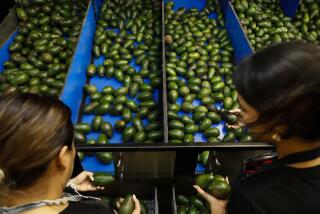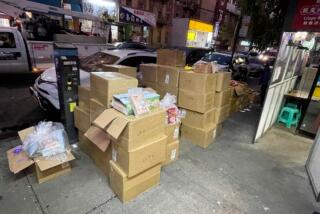Chinese food makers learn to swallow scrutiny, controls
SHANGHAI — Chinese exports of foods including garlic, honey and fish fell sharply this summer as Beijing officials tightened health and safety regulations. That has meant increased revenue for some American growers whose products are now in greater demand -- but also higher prices for U.S. consumers.
Stepped-up enforcement by Chinese officials, who are trying to restore confidence in the Made in China label after a series of product-safety scares, has included aggressive inspection of certain food producers and new requirements in some cases, such as putting tracking stickers on every outbound box and increasing testing for a wider range of food- and soil-borne diseases.
In China’s garlic capital in Shandong province, many of the larger exporters were forced to stop production during much of the summer while inspectors went through their plants and books. Some were ordered to install stainless-steel ceilings in factories and add new record-keeping systems. They said every container headed for the U.S. was being checked before loading, instead of 1 of every 15 or so, as before.
The result: Chinese garlic exports to the U.S. fell 39% in July from a year earlier -- a stark contrast to the 59% year-over-year increase in the first half of 2007, the latest Chinese customs data show. August figures weren’t likely to be much different.
“It’s a heavy burden for us, but we have no choice,” said Yang Shenming, trade manager at Hongchang Fruits & Vegetable Products Co., which resumed shipping this month.
Yang, though, worries about the future. He said that before this summer he could fill an overseas order in seven days. Now it takes at least three weeks because of new inspections and lab tests. Among his added costs: dinner for government inspectors working late.
U.S. importers haven’t reported quality problems with Chinese garlic. But Chinese officials aren’t taking chances with some of their biggest food exports. China is the world’s largest producer of garlic, supplying more than 80% of the crop imported into the U.S.
The influx of Chinese garlic in recent years has been a sensitive issue because it often sells for about half the price of U.S.-grown garlic. That’s hurt farmers in Gilroy, Calif., the self-proclaimed U.S. garlic capital. But the latest slowdown in Chinese shipments has reduced supplies, pushing up demand -- and prices -- for California-grown garlic.
Effects from the slide in Chinese garlic exports have been a bit of a boon to Garlic Co. in Bakersfield, where co-owner Joe Lane said he had raised prices.
A year ago, the garlic supplier sold whole bulbs for 80 cents to $1 a pound, he said. Now, Lane is able to sell them for $1.20 to $1.50 a pound.
“We’re pleased with the price but the sad thing is, we can’t react quick enough to increase our supplies to really take advantage of the situation,” he said, adding that it took a year to grow a crop of garlic.
China’s government has said that 99% of the nation’s food exports to the U.S. -- totaling about $3.8 billion in 2006 -- passed muster in each of the last three years. But after tainted pet food ingredients from China sickened and killed thousands of dogs and cats in the U.S. this year, scrutiny of Chinese-produced food has intensified.
U.S. regulators have restricted Chinese imports of shrimp, eel and catfish because they were found to have unacceptable amounts of antibiotics and other chemical residues. California importers have recalled ginger and fish from China, adding to the list of recalls of Chinese-made goods this year, including toothpaste, tires and toys.
Although some of the problems stemmed from design flaws and differing drug regulations, Chinese officials have acknowledged that their country needed to raise standards, modernize food production and strengthen inspection and supervision of exports.
China’s chief inspector of exported food, Wang Daning, said this month that he was adding 300 workers at ports to his bureau’s overall current staffing of about 7,000. He said he was trying to get many inspectors out of desk jobs and into the field, although he was rotating inspectors making plant visits to reduce corruption. Companies that don’t measure up would be blacklisted.
But Wang and his crew face significant challenges, and nobody expects speedy improvements. Analysts say China’s rapid economic growth has simply outstripped Beijing’s capacity to regulate the food industry.
Wang said about 12,700 processors had export licenses. An undisclosed number are monitored very closely at their factories and loading docks. But China has about 450,000 food-processing companies, most with fewer than 10 employees. It’s some of these small, unlicensed and unscrupulous manufacturers, such as the two blamed in the pet food scandal, that present the biggest problem for China’s efforts to improve food safety.
“There is an old saying in China that as virtue rises 1 foot, vice rises 10,” said Wang, an official with the General Administration of Quality Supervision, Inspection and Quarantine. “Many of the food-quality problems we found overseas, after our investigation, was that a large proportion of them are exporting illegally. . . doing things to avoid and escape inspection and supervision and exporting unqualified products.”
Chinese officials hope to stop some illegal shipments by suspending export licenses and publicizing the names of companies that violate regulations. At the moment, the blacklist has about 55 businesses, although there are indications that some are continuing to export.
Apart from these companies, a number of other food exporters said they had voluntarily cut back or stopped doing business with U.S. customers because of the increased government enforcement and political sensitivity surrounding food shipments.
“We do not dare to accept American orders. . . . The risk is too high,” said Chen Haibin, director of quality assurance for Guangzhou Hengfa Aquatic Product Co., a large supplier of tilapia, cuttlefish and other farm-raised seafood.
China’s customs data show that shrimp exports to the U.S. fell more than 50% in July from a year earlier. Shipments of squid and cuttlefish were also down sharply, as were some agricultural products such as honey, which Chinese beekeepers said was because of tougher restrictions imposed by China as well as export countries. Sales of apple juice and roasted eel, two of the nation’s biggest food exports, continued to grow strongly through July.
Overall, food accounted for just 2% of China’s $128 billion of exports to the U.S. this year through July, according to Chinese customs figures. Toys -- the subject of numerous recalls -- accounted for even less. Thus far, there is no indication in official data of a slowdown in Chinese exports of toys and most other products to the U.S.
But “if the food and toy problems are not resolved,” said Andy Rothman, an analyst at investment bank CLSA in Shanghai, “China’s image may be hurt enough that foreign companies and consumers become reluctant to buy computers, telecom switches and machine tools made in China.”
In Rothman’s view, the overall quality of Chinese exports has been improving. He cites the success of Chinese-produced food in Japan, where customers are notoriously particular, although Japanese consumers reportedly are now shunning matsutake mushrooms from China because of safety concerns.
Rothman added that despite some political missteps, China’s government has taken positive actions in response to concerns. It has pledged to spend $1 billion on food safety by 2010 while closing 3,191 unlicensed and substandard food makers and seizing 4.9 million tons of banned pesticides during the first half of 2007. But Rothman also believes that Beijing’s efforts will be hampered by poverty, the nation’s absence of rule of law and a lack of press freedom.
Zhou Qiushu, general manager of one of China’s largest tilapia producers, has no doubt that his government is serious about improving food safety and quality.
Every day, he says, two or three inspectors show up at Shenzhen Allied Aquatic Produce Development Ltd. to collect samples and look through shipments and records. If that weren’t enough, cameras placed throughout the factory grounds feed live video of the food-making process to officials in Beijing.
Beginning this month, Zhou’s workers have to attach labels with government seals and tracking identification on every box of fish loaded onto containers. Before the containers are hoisted onto ships, he said, every one is now supposed to be opened and checked by inspectors.
“I think the government has racked its brain to improve the situation. . . . The strength of the measures and punishment is unprecedented,” he said.
“But the crucial problem is the honesty of the entire society. If the honesty system is not built, even more regulations won’t touch the root of these problems.”
--
Times staff writer Andrea Chang in Los Angeles contributed to this report.
More to Read
Sign up for Essential California
The most important California stories and recommendations in your inbox every morning.
You may occasionally receive promotional content from the Los Angeles Times.











